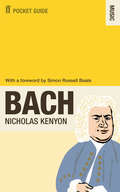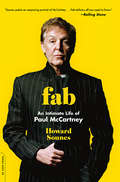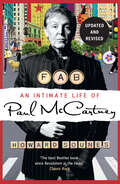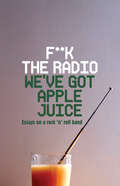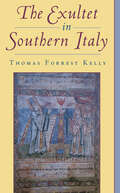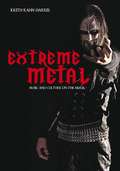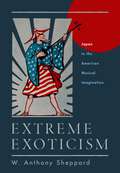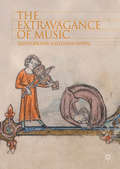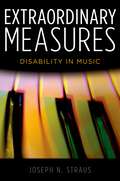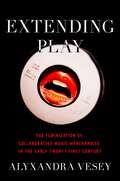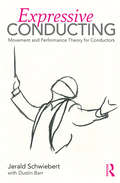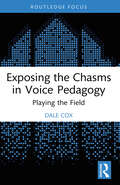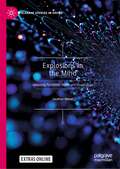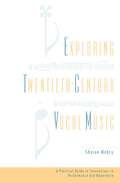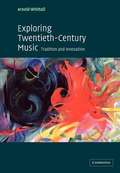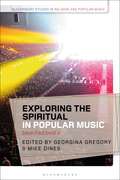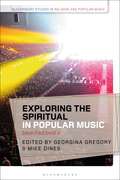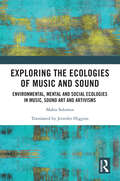- Table View
- List View
The Faber Pocket Guide to Bach
by Sir Nicholas Kenyon CBEThe music of J.S.Bach has a unique power and attraction some 300 years after it was written. From annual performances of the great Passions and BBC Radio 3's hugely successful Bach Christmas, to its use in adverts, films and popular arrangements, the imaginative strength of Bach's music continues to draw listeners to explore its mysteries.This new Pocket Guide looks at all Bach's music, sacred and secular, and explores why he speaks so profoundly to our age about both the spiritual and the sensual in life.Among the features of this easy-to-use book:The Bach Top TenBach: The music work by workPerforming Bach today Bach: The life year by year What people said about Bach Accessible and easy to use, Nicholas Kenyon provides for the first time an up-to-date survey of all Bach's major works in the light of the latest research, from Masses to Cantatas, Concertos to Suites, and recommends the best CDs and further reading.
Fab: An Intimate Life of Paul McCartney
by Howard SounesHoward Sounes, the bestselling author of Down the Highway: The Life of Bob Dylan and Charles Bukowski: Locked in the Arms of a Crazy Life, turns his considerable reporting and storytelling skills to one of the most famous, talented-and wealthiest-men alive: Paul McCartney.Fab is the first exhaustive biography of the legendary musician; it tells Sir Paul's whole life story, from childhood to present day, from working-class Liverpool beginnings to the cultural phenomenon that was The Beatles to his many solo incarnations.Fab is the definitive portrait of McCartney, a man of contradictions and a consummate musician far more ruthless, ambitious, and moody than his relaxed public image implies. Based on original research and more than two hundred new interviews, Fab also reveals for the first time the full story of his two marriages, romances, family feuds, phenomenal wealth, and complex relationships with his fellow ex-Beatles.
Fab: An Intimate Life Of Paul Mccartney
by Howard SounesThe living embodiment of The Beatles, a musical juggernaut without parallel, Paul McCartney is undoubtedly the senior figure in pop music today. In this authoritative biography, journalist and acclaimed author Howard Sounes leaves no stone unturned in building the most accurate and extensive profile yet of music's greatest living legend.
F**k The Radio, We've Got Apple Juice: Essays on a Rock 'n' Roll Band
by Miranda WardWhat happens when getting played on Radio 1 isn't the goal anymore? What if music is really just about music?A few years ago, Little Fish were signed to a major label and recorded an album in LA. They've toured with some big names (last year Debbie Harry saw them supporting Courtney Love and asked them to join Blondie for a UK tour, for instance) and played all over the world.But earlier this year, they did the opposite of what the traditional rock n' roll myth says you should do: they came home again. They left their label, set up a recording studio in an Oxford bungalow, and started doing the things that made them happy, instead of the things they thought they should do to get played on Radio 1. They sent hand-letter-pressed cards to their fans, held raffles in the middle of their gigs, and played acoustic sets at local open mic nights.Independence has raised a lot of questions for Little Fish. Why do we make music? What do people want from bands? How do you create a community? How can we make a living? What is a living? Joined by friend and writer Miranda Ward, who quit her job to follow them on their adventure, they plan to explore these questions, even if they never find answers, and to tell the stories about being in a band that you don't get to hear in NME.F**k the Radio is a book about Little Fish, but it's also a book about making it work, making your own way, and making stuff - music, comics, t-shirts, fishy paper squares, stickers, badges, vinyl, stop-motion animations, even books. And fresh apple juice. It's about declaring your independence and rewriting the myths you live by.
The Exultet in Southern Italy
by Thomas Forrest KellyThe Exultet rolls of southern Italy are parchment scrolls containing text and music for the blessing of the great Easter candle; they contain magnificent illustrations, often turned upside down with respect to the text, The Exultet in Southern Italy provides a broad perspective on this phenomenon that has long attracted the interest of those interested in medieval art, liturgy, and music. This book considers these documents in the cultural and liturgical context in which they were made, and provides a perspective on all aspects of this particularly southern Italian practice. While previous studies have concentrated on the illustrations in these rolls, Kelly's book also looks at the particular place of the Exultet in changing ceremonial practices, provides background on the texts and music used in southern Italy, and inquires into the manufacture and purpose of the Exultets--why they were made, who owned them, and how they were used.
Extreme Metal: Music and Culture on the Edge
by Keith Kahn-HarrisExtreme metal--one step beyond heavy metal--can appear bizarre or terrifying to the uninitiated. Extreme metal musicians have developed an often impenetrable sound that teeters on the edge of screaming, incomprehensible noise. Extreme metal circulates on the edge of mainstream culture within the confines of an obscure 'scene', in which members explore dangerous themes such as death, war and the occult, sometimes embracing violence, neo-fascism and Satanism. In the first book-length study of extreme metal, Keith Kahn-Harris draws on first-hand research to explore the global extreme metal scene. He shows how the scene is a space in which members creatively explore destructive themes, but also a space in which members experience the everyday pleasures of community and friendship.Including interviews with band members and fans, from countries ranging from the UK and US to Israel and Sweden, Extreme Metal: Music and Culture on the Edge demonstrates the power and subtlety of an often surprising and misunderstood musical form.
Extreme Metal: Music and Culture on the Edge
by Keith Kahn-HarrisExtreme metal--one step beyond heavy metal--can appear bizarre or terrifying to the uninitiated. Extreme metal musicians have developed an often impenetrable sound that teeters on the edge of screaming, incomprehensible noise. Extreme metal circulates on the edge of mainstream culture within the confines of an obscure 'scene', in which members explore dangerous themes such as death, war and the occult, sometimes embracing violence, neo-fascism and Satanism. In the first book-length study of extreme metal, Keith Kahn-Harris draws on first-hand research to explore the global extreme metal scene. He shows how the scene is a space in which members creatively explore destructive themes, but also a space in which members experience the everyday pleasures of community and friendship.Including interviews with band members and fans, from countries ranging from the UK and US to Israel and Sweden, Extreme Metal: Music and Culture on the Edge demonstrates the power and subtlety of an often surprising and misunderstood musical form.
Extreme Exoticism: Japan in the American Musical Imagination
by W. Anthony SheppardTo what extent can music be employed to shape one culture's understanding of another? In the American imagination, Japan has represented the "most alien" nation for over 150 years. This perceived difference has inspired fantasies--of both desire and repulsion--through which Japanese culture has profoundly impacted the arts and industry of the U.S. While the influence of Japan on American and European painting, architecture, design, theater, and literature has been celebrated in numerous books and exhibitions, the role of music has been virtually ignored until now. W. Anthony Sheppard's Extreme Exoticism offers a detailed documentation and wide-ranging investigation of music's role in shaping American perceptions of the Japanese, the influence of Japanese music on American composers, and the place of Japanese Americans in American musical life. Presenting numerous American encounters with and representations of Japanese music and Japan, this book reveals how music functions in exotic representation across a variety of genres and media, and how Japanese music has at various times served as a sign of modernist experimentation, a sounding board for defining American music, and a tool for reshaping conceptions of race and gender. From the Tin Pan Alley songs of the Russo-Japanese war period to Weezer's Pinkerton album, music has continued to inscribe Japan as the land of extreme exoticism.
Extreme Exoticism: Japan in the American Musical Imagination
by W. Anthony SheppardTo what extent can music be employed to shape one culture's understanding of another? In the American imagination, Japan has represented the "most alien" nation for over 150 years. This perceived difference has inspired fantasies--of both desire and repulsion--through which Japanese culture has profoundly impacted the arts and industry of the U.S. While the influence of Japan on American and European painting, architecture, design, theater, and literature has been celebrated in numerous books and exhibitions, the role of music has been virtually ignored until now. W. Anthony Sheppard's Extreme Exoticism offers a detailed documentation and wide-ranging investigation of music's role in shaping American perceptions of the Japanese, the influence of Japanese music on American composers, and the place of Japanese Americans in American musical life. Presenting numerous American encounters with and representations of Japanese music and Japan, this book reveals how music functions in exotic representation across a variety of genres and media, and how Japanese music has at various times served as a sign of modernist experimentation, a sounding board for defining American music, and a tool for reshaping conceptions of race and gender. From the Tin Pan Alley songs of the Russo-Japanese war period to Weezer's Pinkerton album, music has continued to inscribe Japan as the land of extreme exoticism.
The Extravagance of Music
by David Brown Gavin HoppsThis book explores the ways in which music can engender religious experience, by virtue of its ability to evoke the ineffable and affect how the world is open to us. Arguing against approaches that limit the religious significance of music to an illustrative function, The Extravagance of Music sets out a more expansive and optimistic vision, which suggests that there is an ‘excess’ or ‘extravagance’ in both music and the divine that can open up revelatory and transformative possibilities. In Part I, David Brown argues that even in the absence of words, classical instrumental music can disclose something of the divine nature that allows us to speak of an experience analogous to contemplative prayer. In Part II, Gavin Hopps contends that, far from being a wasteland of mind-closing triviality, popular music frequently aspires to elicit the imaginative engagement of the listener and is capable of evoking intimations of transcendence. Filled with fresh and accessible discussions of diverse examples and forms of music, this ground-breaking book affirms the disclosive and affective capacities of music, and shows how it can help to awaken, vivify, and sustain a sense of the divine in everyday life.
The Extravagance of Music
by David Brown Gavin HoppsThis book explores the ways in which music can engender religious experience, by virtue of its ability to evoke the ineffable and affect how the world is open to us. Arguing against approaches that limit the religious significance of music to an illustrative function, The Extravagance of Music sets out a more expansive and optimistic vision, which suggests that there is an ‘excess’ or ‘extravagance’ in both music and the divine that can open up revelatory and transformative possibilities. In Part I, David Brown argues that even in the absence of words, classical instrumental music can disclose something of the divine nature that allows us to speak of an experience analogous to contemplative prayer. In Part II, Gavin Hopps contends that, far from being a wasteland of mind-closing triviality, popular music frequently aspires to elicit the imaginative engagement of the listener and is capable of evoking intimations of transcendence. Filled with fresh and accessible discussions of diverse examples and forms of music, this ground-breaking book affirms the disclosive and affective capacities of music, and shows how it can help to awaken, vivify, and sustain a sense of the divine in everyday life.
Extraordinary Measures: Disability in Music
by Joseph N. StrausApproaching disability as a cultural construction rather than a medical pathology, this book studies the impact of disability and concepts of disability on composers, performers, and listeners with disabilities, as well as on discourse about music and works of music themselves. For composers with disabilities--like Beethoven, Delius, and Schumann--awareness of the disability sharply inflects critical reception. For performers with disabilities--such as Itzhak Perlman and Evelyn Glennie--the performance of disability and the performance of music are deeply intertwined. For listeners with disabilities, extraordinary bodies and minds may give rise to new ways of making sense of music. In the stories that people tell about music, and in the stories that music itself tells, disability has long played a central but unrecognized role. Some of these stories are narratives of overcoming-the triumph of the human spirit over adversity-but others are more nuanced tales of accommodation and acceptance of life with a non-normative body or mind. In all of these ways, music both reflects and constructs disability.
Extraordinary Measures: Disability in Music
by Joseph N. StrausApproaching disability as a cultural construction rather than a medical pathology, this book studies the impact of disability and concepts of disability on composers, performers, and listeners with disabilities, as well as on discourse about music and works of music themselves. For composers with disabilities--like Beethoven, Delius, and Schumann--awareness of the disability sharply inflects critical reception. For performers with disabilities--such as Itzhak Perlman and Evelyn Glennie--the performance of disability and the performance of music are deeply intertwined. For listeners with disabilities, extraordinary bodies and minds may give rise to new ways of making sense of music. In the stories that people tell about music, and in the stories that music itself tells, disability has long played a central but unrecognized role. Some of these stories are narratives of overcoming-the triumph of the human spirit over adversity-but others are more nuanced tales of accommodation and acceptance of life with a non-normative body or mind. In all of these ways, music both reflects and constructs disability.
Extending Play: The Feminization of Collaborative Music Merchandise in the Early Twenty-First Century
by Alyxandra VeseyDespite the hypervisibility of a constellation of female pop stars, the music business is structured around gender inequality. As a result, women in the music industry often seize on self-branding opportunities in fashion, cosmetics, food, and technology for the purposes of professional longevity. Extending Play examines the ubiquity of brand partnerships in the contemporary music industry through the lens of feminized labor, to demonstrate how female artists use them as a resource for artistic expression and to articulate forms of popular feminism through self-commodification. In this book, author Alyxandra Vesey examines this type of promotional work and examines its proliferation in the early 21st century. Though brand partnerships exist across all media industries, they are a distinct phenomenon for the music business because of their associations with fan club merchandise, concert merchandise, and lifestyle branding, often foregrounding women's participation in shaping these economies through fan labor and image management. Through textual and discourse analysis of artists' songs, music videos, interviews, social media usage, promotional campaigns, marketing strategies, and business decisions, Extending Play investigates how female musicians co-create branded feminine-coded products like perfume, clothes, makeup, and cookbooks and masculine-coded products like music equipment as resources to work through their own ideas about gender and femininity as workers in industries that often use sexism and ageism to diminish women's creative authority and diminish the value of the recording in order to incentivize musicians to internalize the demands of industrial convergence. By merging star studies, popular music studies, and media industry studies, Extending Play proposes an integrated methodology for approaching contemporary cultural history that demonstrates how female-identified musicians have operated as both a hub for industrial convergence and as music industry professionals who use their extramusical skills to reassert their creative acumen.
Extending Play: The Feminization of Collaborative Music Merchandise in the Early Twenty-First Century
by Alyxandra VeseyDespite the hypervisibility of a constellation of female pop stars, the music business is structured around gender inequality. As a result, women in the music industry often seize on self-branding opportunities in fashion, cosmetics, food, and technology for the purposes of professional longevity. Extending Play examines the ubiquity of brand partnerships in the contemporary music industry through the lens of feminized labor, to demonstrate how female artists use them as a resource for artistic expression and to articulate forms of popular feminism through self-commodification. In this book, author Alyxandra Vesey examines this type of promotional work and examines its proliferation in the early 21st century. Though brand partnerships exist across all media industries, they are a distinct phenomenon for the music business because of their associations with fan club merchandise, concert merchandise, and lifestyle branding, often foregrounding women's participation in shaping these economies through fan labor and image management. Through textual and discourse analysis of artists' songs, music videos, interviews, social media usage, promotional campaigns, marketing strategies, and business decisions, Extending Play investigates how female musicians co-create branded feminine-coded products like perfume, clothes, makeup, and cookbooks and masculine-coded products like music equipment as resources to work through their own ideas about gender and femininity as workers in industries that often use sexism and ageism to diminish women's creative authority and diminish the value of the recording in order to incentivize musicians to internalize the demands of industrial convergence. By merging star studies, popular music studies, and media industry studies, Extending Play proposes an integrated methodology for approaching contemporary cultural history that demonstrates how female-identified musicians have operated as both a hub for industrial convergence and as music industry professionals who use their extramusical skills to reassert their creative acumen.
Expressive Conducting: Movement and Performance Theory for Conductors
by Jerald Schwiebert Dustin BarrExpressive Conducting: Movement and Performance Theory for Conductors applies the insight of movement and performance theory to the practice of conducting, offering a groundbreaking new approach to conducting. Where traditional conducting pedagogies often place emphasis on training parts of the body in isolation, Expressive Conducting teaches conductors to understand their gestures as part of an interconnected system that incorporates the whole body. Rather than emphasizing learning specific patterns and gestures, this book enables student and professional conductors to develop a conducting technique that is centered around expressing the themes of the music. Drawing parallels to the worlds of acting, this text treats the body as the conductor’s instrument. Coaching notes derived from years of experience as a performance movement specialist offer readers approachable methods for eliminating communication barriers—both conscious and subconscious—to encourage optimal performance, highlighting acting theory, movement exercises and the significance of weight distribution. Unlike other conducting approaches, this text understands that conducting resonates throughout the entire body and is not conveyed by the hands or baton alone. With a comprehensive consideration of the conductor’s body and movements, featuring over 50 original illustrations, Expressive Conducting advances strategies for improving one’s conducting skills in rehearsal and performance. Jerald Schwiebert has developed a practical language for expressive conducting. Together, Schwiebert and Barr present a text that is suitable for conducting students, instructors, and professionals alike.
Expressive Conducting: Movement and Performance Theory for Conductors
by Jerald Schwiebert Dustin BarrExpressive Conducting: Movement and Performance Theory for Conductors applies the insight of movement and performance theory to the practice of conducting, offering a groundbreaking new approach to conducting. Where traditional conducting pedagogies often place emphasis on training parts of the body in isolation, Expressive Conducting teaches conductors to understand their gestures as part of an interconnected system that incorporates the whole body. Rather than emphasizing learning specific patterns and gestures, this book enables student and professional conductors to develop a conducting technique that is centered around expressing the themes of the music. Drawing parallels to the worlds of acting, this text treats the body as the conductor’s instrument. Coaching notes derived from years of experience as a performance movement specialist offer readers approachable methods for eliminating communication barriers—both conscious and subconscious—to encourage optimal performance, highlighting acting theory, movement exercises and the significance of weight distribution. Unlike other conducting approaches, this text understands that conducting resonates throughout the entire body and is not conveyed by the hands or baton alone. With a comprehensive consideration of the conductor’s body and movements, featuring over 50 original illustrations, Expressive Conducting advances strategies for improving one’s conducting skills in rehearsal and performance. Jerald Schwiebert has developed a practical language for expressive conducting. Together, Schwiebert and Barr present a text that is suitable for conducting students, instructors, and professionals alike.
Exposing the Chasms in Voice Pedagogy: Playing the Field
by Dale CoxThis concise book critically examines the intersection of power, privilege, and classical music in higher education through an extensive study of the experiences, training, and background of teachers of musical theatre singing.Mapping the divides within the voice pedagogy field, it shows how despite the growth of non-classical programmes, the teaching of vocal music in the United States continues to be structurally dominated by Western classical music. Drawing on extensive fieldwork and observations of practicing instructors, the author argues that current voice pedagogy training’s classical-centred approach fails to prepare instructors to teach the range of vocal styles needed in the contemporary musical theatre profession. Combining a critical review of existing practices with proposals for change, this book sheds light on a key problem in voice pedagogy today.Based on field research and drawing on both Shulman’s signature pedagogies theory and Bourdieu’s concepts of habitus, capitals, practice, and field, this book will be useful for scholars, researchers, and practitioners of voice pedagogy, higher music education, performance education, cultural studies, music, musical theatre, and theatre studies.
Exposing the Chasms in Voice Pedagogy: Playing the Field
by Dale CoxThis concise book critically examines the intersection of power, privilege, and classical music in higher education through an extensive study of the experiences, training, and background of teachers of musical theatre singing.Mapping the divides within the voice pedagogy field, it shows how despite the growth of non-classical programmes, the teaching of vocal music in the United States continues to be structurally dominated by Western classical music. Drawing on extensive fieldwork and observations of practicing instructors, the author argues that current voice pedagogy training’s classical-centred approach fails to prepare instructors to teach the range of vocal styles needed in the contemporary musical theatre profession. Combining a critical review of existing practices with proposals for change, this book sheds light on a key problem in voice pedagogy today.Based on field research and drawing on both Shulman’s signature pedagogies theory and Bourdieu’s concepts of habitus, capitals, practice, and field, this book will be useful for scholars, researchers, and practitioners of voice pedagogy, higher music education, performance education, cultural studies, music, musical theatre, and theatre studies.
Explosions in the Mind: Composing Psychedelic Sounds and Visualisations (Palgrave Studies in Sound)
by Jonathan WeinelThis book explores how to compose sounds and visualisations that represent psychedelic hallucinations and experiences of synaesthesia. Through a detailed discussion regarding compositional methodologies and technical approaches, the book aims to educate students, practitioners, and researchers working in related areas. It weaves together sound, visual design, and code across a range of media, providing conceptual approaches, theoretical insights, and practical strategies, which unlock new design frameworks for composing psychedelic sounds and visualisations.
Exploring Twentieth-Century Vocal Music: A Practical Guide to Innovations in Performance and Repertoire
by Sharon MabryThe vocal repertoire of the twentieth century--including works by Schoenberg, Boulez, Berio, Larsen, and Vercoe--presents exciting opportunities for singers to stretch their talents and demonstrate their vocal flexibility. Contemporary composers can be very demanding of vocalists, requiring them to recite, trill, and whisper, or to read non-traditional scores. For singers just beginning to explore the novelties of the contemporary repertoire, Exploring Twentieth-Century Vocal Music is an ideal guide. Drawing on over thirty years of experience teaching and performing the twentieth century repertoire, Sharon Mabry has written a cogent and insightful book for singers and voice teachers who are just discovering the innovative music of the twentieth century. The book familiarizes readers with the new and unusual notation systems employed by some contemporary composers. It suggests rehearsal techniques and vocal exercises that help singers prepare to tackle the repertoire. And the book offers a list of the most important and interesting works to emerge in the twentieth century, along with suggested recital programs that will introduce audiences as well as singers to this under-explored body of music.
Exploring Twentieth-century Music: Tradition And Innovation (PDF)
by Arnold WhittallIn this wide-ranging book, Arnold Whittall considers a group of important composers of the twentieth century, including Debussy, Webern, Schoenberg, Stravinsky, Bartók, Janácek, Britten, Carter, Birtwistle, Andriessen and Adams. He moves skilfully between the cultural and the technical, the general and the particular, to explore the various contexts and critical perspectives which illuminate certain works by these composers. Considering the extent to which place and nationality contribute to the definition of musical character, he investigates the relevance of such images as mirroring and symmetry, the function of genre and the way types of identity may be suggested by such labels as classical, modernist, secular, sacred radical, traditional. These categories are considered as flexible and interactive and they generate a wide-ranging series of narratives delineating some of the most fundamental forces which affected composers and their works within the complex and challenging world of the twentieth century.
Exploring the Spiritual in Popular Music: Beatified Beats (Bloomsbury Studies in Religion and Popular Music)
by Mike Dines and Georgina GregoryThis book highlights how the diverse nature of spiritual practices are experienced and manifest through the medium of popular music. At first glance, chapters on Krishnacore, the Rave Church phenomenon and post-punk repertoire of Psychic TV may appear to have little in common; however, this book draws attention to some of the similarities of the nuances of spiritual expression that underpin the lived experience of popular music. As an interdisciplinary volume, the extensive introduction unpacks and clarifies terminology relating to the study of religion and popular music.The cross-disciplinary approach of the book makes it accessible and appealing to scholars of religious studies, cultural studies, popular music studies and theology. Unlike existing collections dealing with popular music and religion that focus on a specific genre, this innovative book offers a range of music and case studies, with chapters written by international contributors.
Exploring the Spiritual in Popular Music: Beatified Beats (Bloomsbury Studies in Religion and Popular Music)
This book highlights how the diverse nature of spiritual practices are experienced and manifest through the medium of popular music. At first glance, chapters on Krishnacore, the Rave Church phenomenon and post-punk repertoire of Psychic TV may appear to have little in common; however, this book draws attention to some of the similarities of the nuances of spiritual expression that underpin the lived experience of popular music. As an interdisciplinary volume, the extensive introduction unpacks and clarifies terminology relating to the study of religion and popular music.The cross-disciplinary approach of the book makes it accessible and appealing to scholars of religious studies, cultural studies, popular music studies and theology. Unlike existing collections dealing with popular music and religion that focus on a specific genre, this innovative book offers a range of music and case studies, with chapters written by international contributors.
Exploring the Ecologies of Music and Sound: Environmental, Mental and Social Ecologies in Music, Sound Art and Artivisms
by Makis SolomosMakis Solomos explores the ecologies of music and sound, inspired by Felix Guattari, for whom environmental destruction caused by capitalism goes hand in hand with deteriorating ways of living and feeling, and for whom an ecosophical stance, combining various ecological registers, offers a glimpse of emancipation, a position strengthened today by intersectional approaches. Solomos explores environmental, mental and social ecologies through the lens of the history of music and current artivisms – especially in the fields of acoustic ecology, contemporary music and sound art. Several theoretical and analytical debates are put forward, including a theory of sound milieus and the biopolitics of sound; the relationships between music and the living world; soundscape compositions, field recording, ecomusicology, and the creation of sound biotopes; the use of sound and music to violent ends as well as considering the social and political functions of music and the autonomy of art, sonic ecofeminism, degrowth in music, and much more.
